by Wine Owners
Posted on 2020-01-27
By Miles Davis, 27th January 2020
Summary
Piedmont is on the up, the area and the wine. The region is extremely picturesque, and the food and wine scene is superb. Winemaking is better than ever with younger generations bursting through full of energy and enthusiasm and the wines are getting better and better. In my experience, they are becoming more approachable too. The natural acidities of the grapes and the soils can handle, if not benefit, from the warmer climate and there have been some very fine vintages in the recent past. In global terms, Piedmont is relatively undiscovered and comparative values to other great regions make for a compelling story – read on!
Background
I have just returned from three glorious days in Piedmont. The weather was fine, the food was finer, and the wines were finer still! As readers will know, I have been singing the virtues of Piemontese wines, and the value they offer, for many months now. I was not expecting to have my enthusiasm heightened, just confirmed really, but this trip exceeded all expectations. I have been a few times before but the combination of seeing some top-notch producers, having a local courtier (David Berry Green, DBG Italia) as a guide, and in the company of both an experienced wine journalist (Victoria Moore, Daily Telegraph) and a wine merchant (Mark Roberts, Decorum Vintners), the stars aligned and we hit some celestial heights.
Compared to Bordeaux and Burgundy, Piedmont has not been making wine for very long, certainly not commercially. Producers have been operating for decades rather than centuries. The Nebbiolo grape that provides us with Barolo and Barbaresco was not even the top variety in the region 30 years ago, that was Dolcetto. Back in the eighties, Conterno Fantino encouraged larger orders by giving away six bottles of Barolo for every sixty bottles Dolcetto ordered! Now Dolcetto vines are being grubbed up and replaced by Nebbiolo - oh how trends change! This one will not be reversed, however. Producers are defensive on Dolcetto, arguing it makes wine for everyday drinking and whilst I really wouldn’t mind drinking Bartolo Mascarello Dolcetto most days, it doesn’t compare to the joys produced by Nebbiolo.
Victoria Moore & David Berry Green - © Miles Davis, Wine Owners
Notes
The striking and salient points derived from the trip were all positive. The region has never generated so much international interest, both generally and in the wine department, but largely thanks to the wine department. In 2014 ‘First floor Landscape of Piedmont: Langhe-Roero and Monferrato’ became the official name of a UNESCO World Heritage Site and this has brought tourism flooding in, although some of it is now becoming a problem. The village of Barolo itself and its 700-800 residents now plays host to international rock concerts; Bob Dylan and Eddie Vedder of Pearl Jam have played to 7,000 (presumably ageing and wine loving) rockers in the last couple of years. Basta! scream the residents, producers are less concerned. The U.S., Germany and England are already major markets for the wines, but others are growing. Australia, Japan, Malaysia, South Korea, Singapore were all mentioned, as was Scandinavia. There was one noticeable absentee – China. ‘Not yet’, the producers said.

© Miles Davis, Wine Owners
The Wines
The wines we tasted were largely brilliant and we all agreed what a good reminder it was when we had our first poor tasting - it offered reassurance that we hadn’t become so inured to the place that we had become complacent! To be fair the Baroli we were tasting were mainly from the fabulous 2016 vintage and we were tasting at very good growers, some famous, some less so, but more on them later.
I was surprised by the approachability of most of the wines, a marked difference to previous experiences. The wines were pale, supple and elegant and with a weightlessness (something that perhaps Nebbiolo can deliver more than any other variety) yet packed with fruit, power and nuance at the same time.
Times have been a-changing in Barolo country and where they haven’t changed too much, the results have improved dramatically. The ‘Barolo wars’ are well documented, indeed there has even been a film made about them and concern the traditionalist approach versus the modern. Briefly, this translates into long maceration periods and ageing in large oak barrels (botti), the traditional approach, versus shorter maceration, temperature controlled fermentation and small oak barrels, the modern. It was interesting to note that the two wineries employing the highest percentage of small oak barrels produced the least good wines. The better wines were made in the traditional way but are harvesting better fruit, implying improved work in First floor.
As with other regions, alcohol levels in Piedmont have been rising, largely due to climate change. Most of the wines tasted were at 14.5%, but such are the natural acidity of Nebbiolo and the soils you really don’t notice, at least not until you’ve had the whole bottle yourself! It is a very different experience compared to drinking Bordeaux wines at the same level. Another local variety, Pelaverga, produces an even paler juice which is amazingly light and fruity. I had just started dreaming of summer barbecues when I noticed G.B. Burlotto’s offering weighed in at 15% - keep it away from the kids!
-G.B. Burlotto © Miles Davis, Wine Owners
The Market
As previously commented on here, the market in Piedmont wines is firm. Without the geopolitical issues currently hanging over the wider market, it would be a fair chunk firmer. The very loudly heralded 2016 will be released this year and buyers are waiting to pounce. If 2010, another great vintage, is anything to go by they most certainly will, and probably in far greater numbers than back then. In the grand scheme of things, Piedmont is an adolescent and will continue to grow. Wine making will continue to improve and prices will rise.
The Producers (in brief) (and not all)
Punset (Nieve) – previously unheard of (by me). Bio-dynamic and very in touch with climate and nature. Only releases when the wines are ready. Marina Marcarino’s Barbaresco Basarin 2013 (a year very similar in weather to the brilliant 1982, her first vintage) is available now. Delicious and only 13% alcohol. So desperate to make wine, she lied to her parents about the course she was taking at University. They wanted her to join their family widget making business – we were all glad she didn’t! Her range is just great, elegant and refined. She may even save the planet too.
G.B. Burlotto (Verduno) – Premier League status and I now know why! Verduno, at the northern tip of Barolo country, is the village of the moment and its best vineyard, Monvigliero, known for its elegance, is the piece of dirt everyone wants a piece of right now. Fabio Alessandria makes c. 8,000 bottles of Monvigliero - Investment Grade ‘A’. His whole range is superb.
Fratelli Alessandria (Verduno) – Cousins of Fabio and not to be confused with the Glaswegian band. Rising up into the Premiership. Traditional methods, improvements in the winery and focusing on improving quality, not expansion. Their Langhe Nebbiolo ‘Prinsiot’ 2016 is already in my cellar for drinking and I’ve been buying ’13 Monvigliero for investment.
Trediberri (La Morra) – Nicola Oberto and his parents bought a 5 hectare site in La Morra in 2008 and have 2 prime hectares of Rocche dell’Annunziata. Definitely one to watch, this guy is on the move and has been studying Bruno Giacosa’s methods. Refreshingly honest, he was genuinely most excited about his recently made Annunziata 2019 - at three months of age! The Langhe Nebbiolo ’19 might be one to sample. Moving from on the radar to gentle accumulation…
Trediberri (La Morra) – Nicola Oberto © Miles Davis, Wine Owners
Roagna (Castiglione Falletto and Barbaresco) – Now in the hands of Luca Roagna, they are one of the few growers making really serious wines in both Barolo and Barbaresco. The star has been rising for some time. Organic with old vines. We tasted wines from the poorly reviewed 2014 vintage (he releases later) at 10 degrees in the cellars. Although the wines were also cold, they sang their heads off. Both from Barbaresco, the Albesani (2,000 bottles) with the most amazing nose and the Montefico (1,000 bottles) stood out for me. Invest with confidence!
Crissante, La Morra – not on my radar before, Alberto has been running this family affair (we met Nonna (his nan), 88 and still dancing) since 2008. The family owns 6 hectares of vines, 5 of hazelnuts and a lovely holiday house they rent out. The Barolo Classico ’16 will ticks a lot of boxes when released. Thier Capalot ’15 will also give immense pleasure. The ’13 is currently available. Firmly on the radar now.
Bartolo Mascarello, Barolo – Investmnent Grade A. Brilliantly understated and traditional with a touch of jazz, but only in the artwork on display. Maria Theresa’s 2018 Dolcetto was superb, the ’16 Barolo sublime. A blend of 4 vineyards with production at 15-20,000 bottles. Genius. Interesting to spot an empty Trediberri box by the back door!
Giovanni Rosso (sounds so much better than Red John!), Serralunga – Proprietor Davide turned up as we were leaving, completely unphased by his tardiness. How someone so laid back has managed to create such a bustling business is amazing; two tasting rooms, one with a full restaurant style kitchen, a helipad, a contract to make BBR house Barolo and sales all over the world. Our impromptu host excelled in showing us the famous Vigna Rhionda vineyard. Once our feet were double caked in clay he informed us the terroir was nearly all limestone! A rushed tasting followed which was a bit inconclusive but with their top cuvée selling at £500+ a bottle, something is working. Another visit required!
Luciano Sandrone, Barolo – impeccable presentation. Famous for their Barolo labels Cannubi Boschis (Aleste since 2013) and Le Vigne, and now the uber rare Vite Talin, that they vinify themselves, they not only sell a lot of grapes from their Roero sites, they also sell finished wine to others. A mixture of traditional and modern. Barbara works with her Uncle Luca, only 3 years apart in age and Luciano (Barbara’s father and Luca’s brother) is still on site having begun his wine life with Giacomo Borgogno, bang next door and right under the slopes of the Cannubi Bioschis vineyard. Great 16s, the 15s also very attractive. Lovely wines, I have been buying and will continue.
Sandrone © Miles Davis, Wine Owners
General comment
It was an inspiring trip and easily surpassed expectation, particularly in the wine department. Growers tend to be family run businesses, are friendly, engaging and genuinely passionate. The bigger businesses are the antithesis of this and, dare I say it, more reminiscent of Bordeaux producers. These personalities are clearly reflected in the wines and different styles are very apparent.
On my return to my desk I found the tail end of the Burgundy 2018 en primeur offerings. The relative prices just do not make sense. On every level, there is no comparison; there are dozens of Grand Cru Burgundies from a host of producers releasing wines at more than c. £150 a bottle, in Piedmont a tiny handful. From a recent release of Giacomo Conterno’s 2015 wines, only the legendary Monfortino (the most expensive wine in all Piedmont) was above this price level. Many Burgundy premier crus cost more than exceptional Barolo cru, village wines more than ‘classico’ blends etc., etc.
For drinkers and those wishing to dip their toe, all of the producers make an entry level wine, be it a Langhe Nebbiolo, a Langhe Rosso or a Nebbiolo d’Alba. These are released earlier than the aged Barolos and offer an inexpensive way of treating yourself and opening the door.
As ever, please fire away with questions.
© Miles Davis, Wine Owners
by Wine Owners
Posted on 2019-11-15
This article is a republished version of one that appeared earlier in the year. Why? Because there’s another reason to sing about the virtues of Italian wines; the Trump administration have recently introduced a 25% tariff on all wines from France, Germany and Spain below a 14.1% alcohol level (Champagne is exempt). This has caused a loss in confidence in the French heavyweights and Bordeaux and Burgundy prices are on the slide. Italy’s cheese industry was the one selected to take the hit in this particular trade war, leaving their wine sector sitting pretty. We’ve been bullish on Italy all year, this adds further grist to the mill.
The Italians are not only the largest wine producing country in the world, they have been making wine for over four thousand years and cultivate over two thousand grape varieties on a multitude of different soils in twenty different regions! They are not bad at food either. Their climate seems to suit most of the finer things in life.
Italian wine being recommended is nothing new, but having it recommended as a collectable asset bearing an investment case is another matter. Ten years or so ago, a few canny collectors realised some of the ‘Super Tuscans’ (red wines typically made of a Bordeaux blend in Tuscany) such as Masseto, Ornellaia, Sassicaia (recent blog) and Solaia were ripe for decent returns. Traditionalists were a bit put out by these glossy new pretenders turning up on the Italian wine scene with their fancy French grape varieties and lots of marketing but it is fair to say they have helped the overall attention given to Italy and, as a result, the ‘Bs’ are blossoming – namely, Barolo, Barbaresco and, to a lesser extent, Brunello.
Wines from the best producers of Italy’s most venerable regions have been collected by the cognoscenti for years but now their appeal is becoming more widespread. The problems of Bordeaux, following an explosive China-driven period, have been well documented in the last decade and in its place, the smaller top-quality regions have been profiting. The indices for the last five years show Burgundy +120%, California +79%, Piedmont +76%, Tuscany +62% and First Growth Bordeaux +47%, the broad base WO 150 is +55% (all nice numbers!).
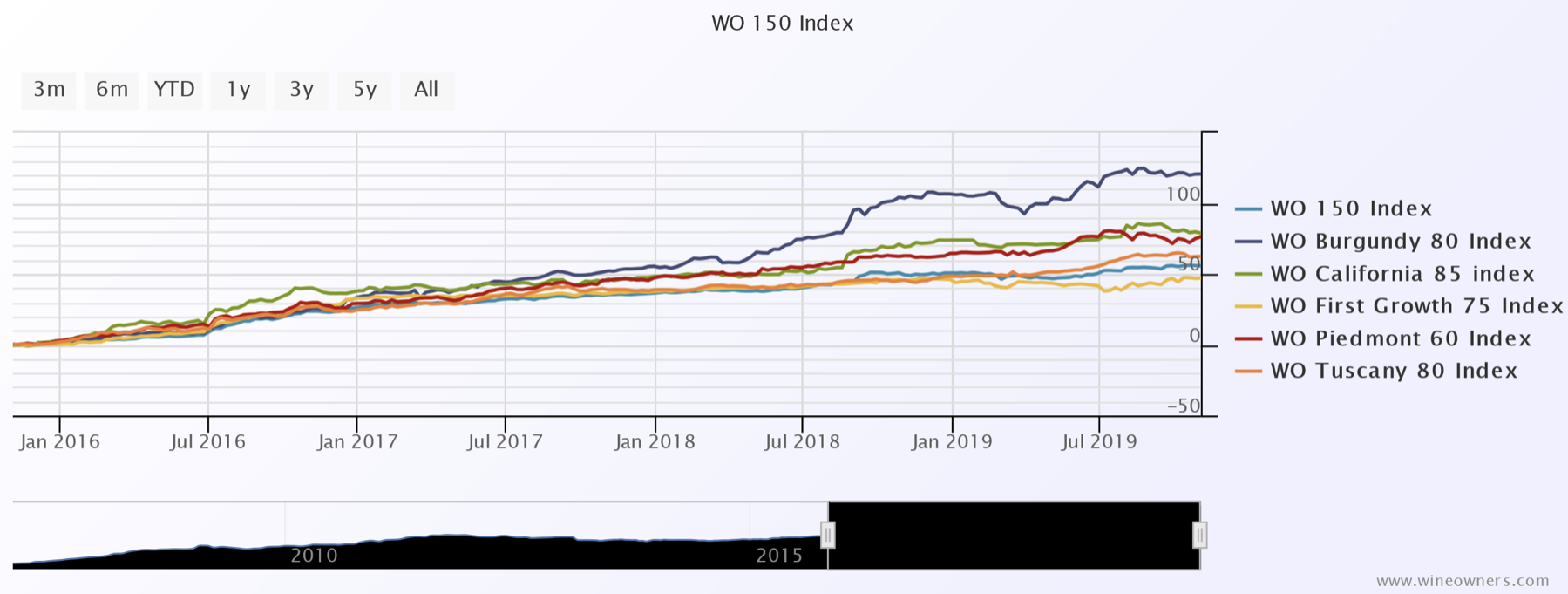
The reason for Burgundy’s performance is that old tried and tested wine world fundamental of genuine demand outstripping supply - who knew!? I think it is fair to say prices in Burgundy have been coming off the top for nearly a year now. Californian prices were a little more ‘forced’ and are in retreat now, but both these regions produce tiny quantities in comparison to the number of people looking to access these markets and gain exposure. Very widely held Bordeaux has been steady but is beginning to slide in this difficult environment. Piedmont and Tuscany are holding firm to gently positive.
The complex nature of Burgundy, California and Piedmont with their tiny (compared to Bordeaux) vineyards is attractive. This adds to the aesthetics, spurring on both the well-seasoned and newcomers alike, keen to learn more and invest time and money accordingly. More of the written word is more easily accessible to interested folk, and with platforms such as Wine Owners to trade on, the visibility of the product and the liquidity of the commodity has increased.
Grand Nebbiolo from Piedmont is yet to hit the big time, apart from a special few producers, but the word is spreading and there are ‘new’ names coming through; dedicated collectors and the inquisitive are homing in. It is a Burgundian-like network of vineyards, producers, families and reputations and you need to know what you are doing. Famous names like Conterno, for example, have six listings in my favourite reference book: Aldo, Diego, Fantino, Franco, Giacomo (the big one) and Paolo.
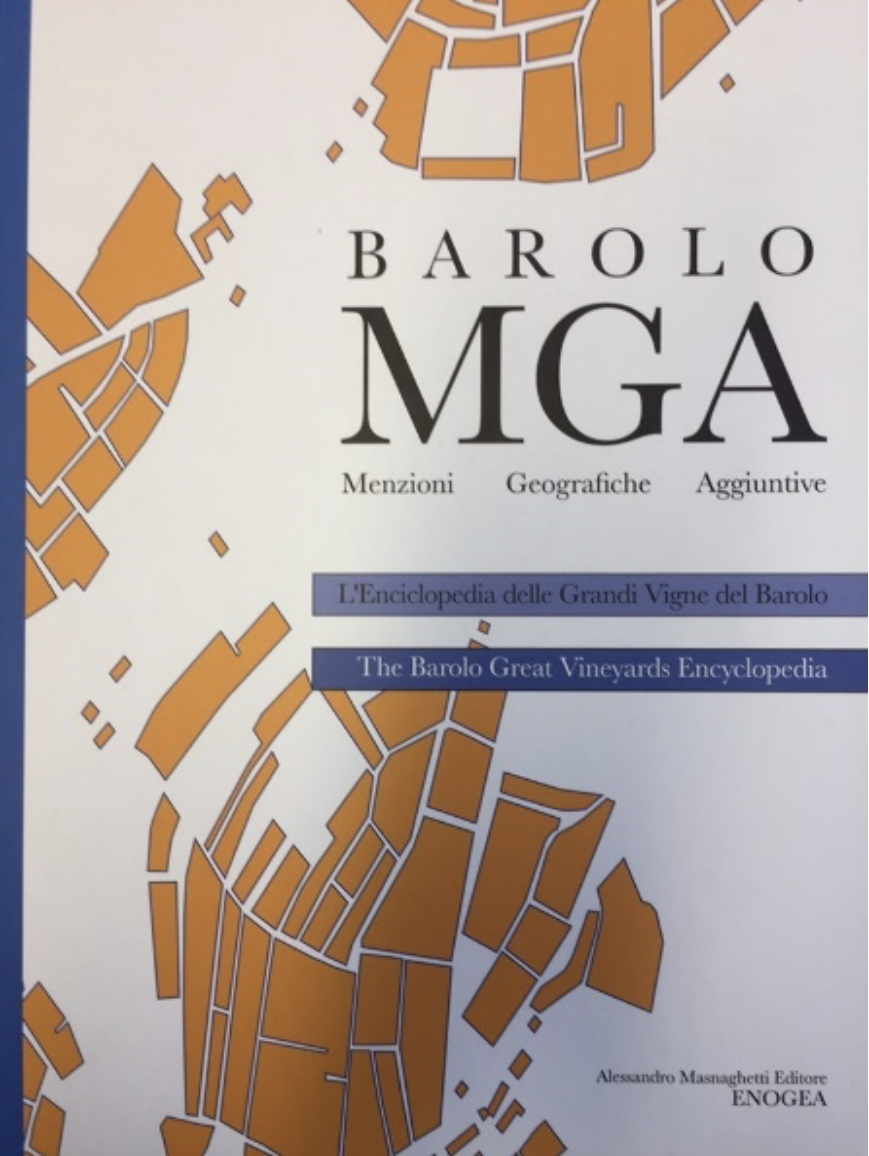
Some of the bigger names like Giacomo Conterno famed for his Montfortino vineyard, Giuseppe Rinaldi, Bartolo Mascarello, Bruno Giacosa and Gaja are already highly sought after superstars, with prices to match, but there are a host of others with reputations and demand beginning to swell; Brovia, Cappellano, Fratelli Alessandria, Sandrone, Voerzio and Vietti to name a few.
The ‘Super Tuscans’ of Bolgheri are much simpler to understand, like Bordeaux versus Burgundy, and are produced in larger numbers. The names mentioned earlier are virtually household names (in wine terms!), are less exciting right now overall but tend to deliver very steady returns.
Brunello di Montalcino, made from Sangiovese, is also comparatively easy to piece together in relation to Piedmont. Biondi Santi, Poggio di Sotto, Salvioni and Soldera are the big names with the fancy price tags. The secondary market for Brunello has not yet developed so, for now at least, it is a case of keeping a watchful eye although Soldera has been added to several portfolios already. There are many other less well-known names that have been attracting huge plaudits from the top critics that remain under the radar. This group haven’t matured into the darlings of the market, so far, and back vintages are cheap and well worth consideration.
There have been some excellent vintages in Italy in the last decade or so, attracting fantastic media coverage and now the battle-weary Bordeaux buyers and profit takers of Burgundy are moving in. Another reason for favouring Italian wines in the current climate is that the U.S. and Germany are the biggest export markets, so the market unlikely to be affected by any potential fallout from Brexit.
Most of all, however, these wines are barely scratching the Asian surface as yet and we all know what happens when that changes!
Miles Davis 15th November 2019

by Wine Owners
Posted on 2019-07-09
The reputation of Luciano Sandrone continues to grow and grow, in keeping with the popularity of Barolo. Not as famous as the very top tier of Bruno Giacosa, Giacomo Conterno or Giuseppe Rinaldi but nestling just in behind, at a far more attractive price point.
Here we consider Le Vigne cru although the story is much the same for the slightly more expensive Cannubi Boschis (renamed Aleste in 2013 – in classic, designed to confuse, Piemonte style!).The consistency of the scores is incredible - through a mixture of very varied vintages from ’06-’15 the average is 95.3 points (Wine Advocate). Very significantly, the estate releases a small amount of the exact wines (under the labels Le Vigne Sibi et Paucis and Cannubi Boschis Sibi et Paucis) after ten years of age and they consistently achieve greater acclaim at that point, the ’07 going from 96 to 99 points (WA) for example. The range of points scored would indicate these are very fine wines indeed and given the rarity, must be only affordable to only the mega rich. Not so, prices start at c. £60 a bottle, rising to c. £170 for the stonking 2010 vintage.
For comparison sake I looked at some other fine wines from Burgundy and Bordeaux over the same ten year time period. Obviously these comparisons will never be exactly like for like but the differentials are not that great either; brilliant producers from the top tier of their respective regions, producing internationally acclaimed wines from the best local grape varieties designed to take advantage of their particular terroirs and climates to the full. We have a decent premier cru Burgundy, Domaine Dujac Aux Combottes, a sensational Pomerol on top of its game, Vieux Chateau Certan, and the king, Chateau Petrus (just for fun):
Comparisons between ‘06-‘15 vintages: |
Av. points
|
Av. Price
|
Highest price
|
Luciano Sandrone Le Vigne Barolo DOCG |
95.3
|
£98
|
£170
|
Domaine Dujac Gevrey Chambertin Aux Combottes Premier Cru |
91.6
|
£170
|
£234
|
Vieux Chateau Certan |
94.1
|
£134
|
£220
|
Petrus |
96.1
|
£2,200
|
£3,250
|
I suggest there is room for significant upside for this Barolo. And I am going to start selling the Combottes I own, the differential is absurd and further illuminates how crazy Burgundy prices have become. Production of fine wine in Barolo (and Barbaresco) is tiny compared to even Burgundy and completely miniscule in what we could consider the ‘investable’ candidates.
Please see charts for Market Price and Relative Value Scores for available vintage comparison.
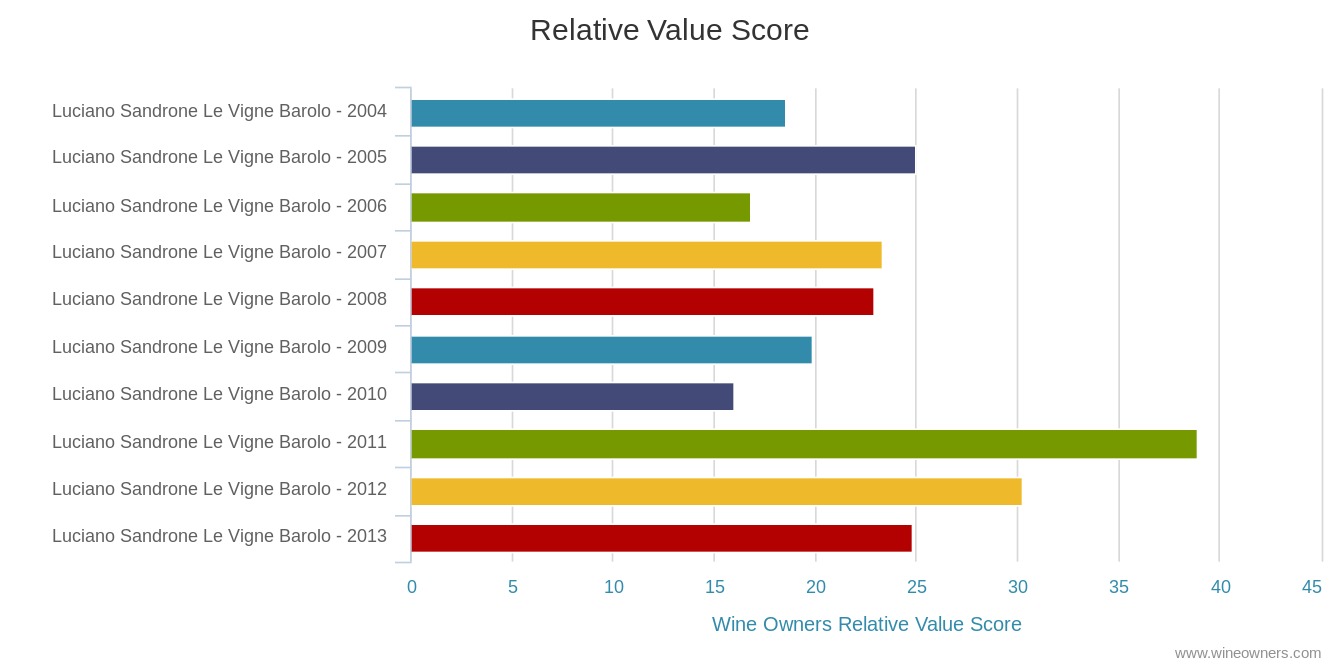
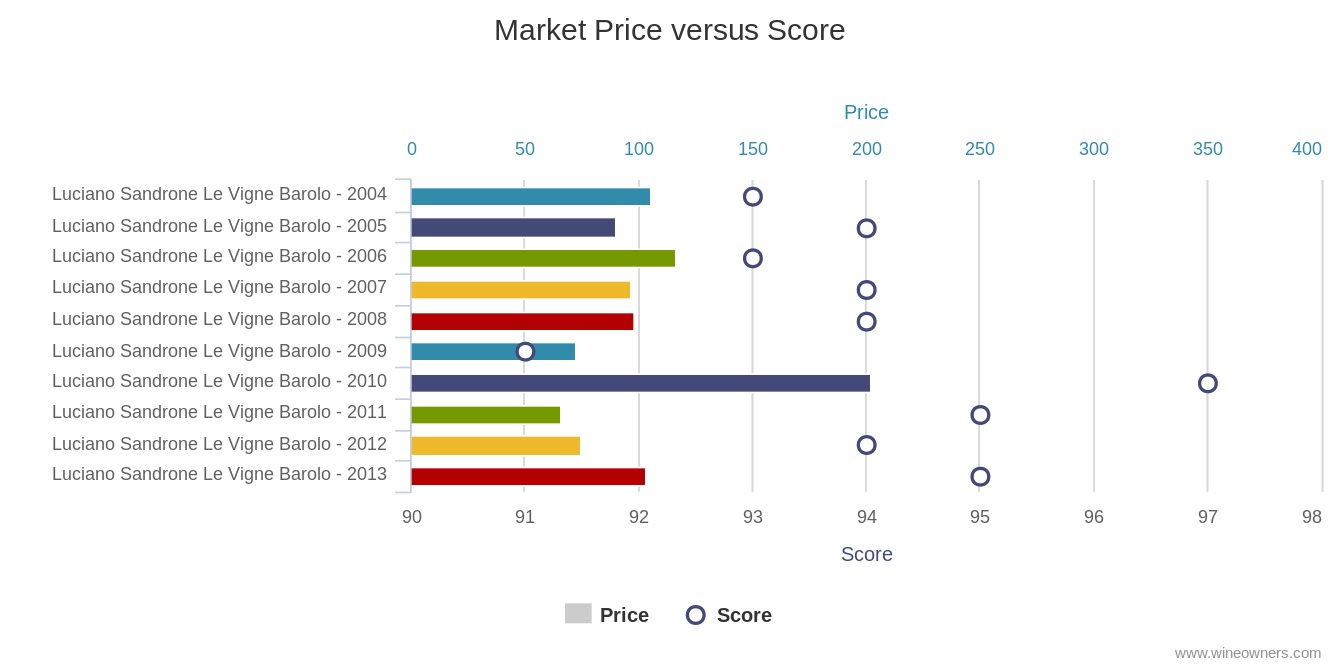
Miles Davis
9th July 2019
by Wine Owners
Posted on 2018-03-05
We would like to echo the sentiments of Lisa Perotti-Brown – the new face of Bordeaux at The Wine Advocate – who revels in reviewing great wines from vintages less hyped than the universally celebrated ones.
A review of past vintages is so much more pleasurable than one of a current vintage. It can be pursued at leisure, far from the madding crowd of en primeur set-piece campaigns. The wines have been in bottle for some years, and have grown into their skins, allowing them to express themselves and harmonise. There is none of the guesswork required when evaluating young wines. And it is not done as part of a tasting Megathon favouring the most obvious, richest wines…
Here follows a spotlight of vintages which hide truly great wines, many of which still represent good value.
Burgundy 2013
Let's start with 2013, the worst climatic year Burgundy has experienced in a long time, characterized by a dreadful summer of cold, sodden weather. But that’s the thing with Burgundy; its growers refused to give up. They never do. They spent the summer in their Aigle wellies desperately battling the filthy elements and sticky, sucking mud. Coaxing what they could out of their precious vines - their livelihood - trying to make the best of a seemingly bad lot. The coaxing process involved leaf thinning, and sacrificing bunches to give the rest a chance at maturing properly. And that is the thing with Pinot Noir; it responds exceptionally favourably to low yields.
Now, if you like dense, sweet fruit with generous alcohols, 2013 may not be the vintage for you. But if you enjoy intensity of flavour without the weight of a hot year, red Burgundies from 2013 will positively surprise you. All the more so if you first tasted barrel samples back in January 2015; the wines are now positively transformed from that first recalcitrant showing.
It’s well known that a warm, accommodating, crisis-free growing season will result in wines that are generous and velvety-textured in their youth. But these aren’t always the wines that develop into fine, complex maturity. Take 1999 for example, lauded as one of the greatest Burgundy vintages of all time. Indeed, some of the wines are astoundingly good. But just as many others are really quite average. Why is that? Over-generous yields. It’s a fine line with Pinot, between harvesting as much ripe fruit as nature provides and allowing the fecund vine to produce as much as it’s wont.
Back to low-yielding 2013, and the best wines are beautifully crystalline, intense and transparent. Think a cornucopia of red fruits, blackberries and gooseberries: the essential ingredients of a refreshing summer pudding – a balancing mélange of sweet and sharp. Add characteristic Burgundy high notes of salinity (and a mineral-tinged, geological nod-in-the-glass to the inland sea of which the Cote d’Or was once a part) and hopefully you’ve formed a fair mental image of 2013 red Burgundy.
It’s no coincidence that blue chip stalwarts such as Eric Rousseau and Christophe Roumier love their 2013s. Aubert de Villaine sees his Domaine de la Romanée 2013s as long distance runners (in contrast to his more ‘forward’ 2014s). And they are delightful.
2013 is also one of the last sensibly priced vintages before Burgundy prices became vertiginous.
Burgundy 2006
Wines from cooler Burgundy vintages often start out rather awkward, and out of kilter. Their acidity may add definition and length, but can also close the wine down, or conspire with tannins to suppress the essential grape characteristics in a wine.
2006 was one such vintage. Its wines were initially hard to taste, and broadly speaking, unlovely. Many of us viewed 2006 Burgundies as unwelcome magpies in our collector’s nest of more comely vintages.
But now, after a decade in bottle, the wines are starting to show very well. They exhibit well-defined fruit, great length and energy. Next to the 2005s, they may lack heft and powerful tannin structure, but they are nonetheless serious, intense wines. And they are beginning to drink well now. You’ll have to wait at least another decade for your 2005s to come around, but 2006 is a fine emerging vintage that will give pleasure now and for the foreseeable future.
Bordeaux 2011
For Bordeaux, 2011 was always going to be a tough sell. On release, the wines seemed scrawny and mean in comparison with the monumental 2009s and 2010s.
Yet a recent dinner event hosted by Wine Owners showed how dangerous it is to tar a whole vintage with the same presumptive brush, or to judge a more classic vintage too early. The highlights of that tasting were Vieux Chateau Certan 2011 and La Mission Haut-Brion 2011. They were both easily the equal of their counterparts from better-regarded vintages, and represent great value compared with any more recent vintage.
Bordeaux 2006
In Bordeaux, 2006 was a vintage that attracted more than its fair share of negative press, the effects of which are still in evidence today, judging by the affordability of 2006 Bordeaux on the Wine Owners Exchange. The success of a Bordeaux vintage depends on sentiment, and in 2006 combination of negative factors came into play.
First, it came on the heels of stellar 2005. Second, Bob Parker’s favourable rating of the vintage attracted criticism from many pundits, attracting further negative attention. Third, the release prices were too expensive– due at least partly to the high Parker scores. Why else would La Mission Haut-Brion be ready to trade at £1,550 per 12x75cl, yet be overlooked?
[ Top tip: buy La Mission Haut-Brion at this level – half of its opening (mis)price. It is considered a ‘wine of the vintage’, rivalled for this accolade only by the (much more expensive) Mouton. ]
We are fans of the Bordeaux 2006 wines we’ve tasted. They don’t have the powdery tannins and powerful black fruit of the 2005s, but they do have superb energy, and a sappy character that compels you to take the next sip. We see many wines from 2006 as more interesting than their counterparts from 2004 or 2008. Notable examples include Mouton, Pontet-Canet, Leoville Barton, Leoville Las Cases, La Conseillante (just a sampled tip of the iceberg). Whenever tasted comparatively, these showed extremely well alongside relative other vintages.
In our experience, where 2006 performs particularly well is its consistency. Simply put, we’ve never had a poor one. Other low-rated back-vintages produced a number of successes (such as 2007, 2011), but none are as consistent as 2006.
Bordeaux 2002
2002 is another Bordeaux vintage which suffered from poor reputation. The year’s poor weather consigned the vintage to the status of ‘restaurant wine’ before any of the wines were even bottled. But it’s easy to forget that the wines were very well priced; first growths were released at around £800 per case (just one-sixth of their 2015 release prices). If you had invested in 2002 Bordeaux 15 years ago, you would be feeling rather smug right now. 2002 is the vintage for the contrarian that lurks inside every wine enthusiast!
While they were never going to be the most profound expressions of Bordeaux (in the light of the meteorological conditions), the 2002s have consistently tasted savoury, fruity, and sweetly spiced with cloves, cinnamon sticks and liquorice root. At all levels of classification, we’ve yet to stumble across a disappointing example.
Piedmont 2002
In 2002 Piedmont, like Bordeaux, suffered from rotten summer weather. Wine commentators have described 2002 in Piedmont in such terms as ‘wiped out’, ‘disastrous’, ‘severely compromised’, ‘a washout’.
But despite all of this, one wine survived the vintage’s humid gloom (and the hailstorms which repeatedly strafed Barolo) with enough salvaged bunches to benefit from perfect autumnal conditions. This is a wine made with such severe selection that yields were just 12 hl/ ha, and which epitomises viticultural triumph against the odds. The wine in question is, of course, the now-mythical Barolo Riserva Monfortino 2002.
Take a moment to consider the sacrifice involved in making wine with yields as low as 12 hl/ ha. Burgundy considers 25 hl/ ha to be painfully low, and in Bordeaux anything under 40 hl/ha is a very short harvest.
Giovanni Conterno – Roberto Conterno’s late father – called 2002 the greatest Monfortino of his lifetime.
The last word must surely go to Antonio Galloni, whose tasting note and review of this wine encapsulates why it’s so rewarding to seek out the greatest wines within those vintages in the shadows:
“…the 2002 Barolo Riserva Monfortino, a wine that may very well turn into a modern-day legend… 2002 was a cold, rainy year that in many parts of Barolo culminated with violent hailstorms in early September. The weather then turned picture-perfect for the rest of the growing season, but by that time most vineyards were severely damaged. The late-ripening Cascina Francia was an exception. Conterno green-harvested aggressively, which gave the fruit a chance to ripen. …The Conternos were so upset by the poor early press reaction to the vintage they announced they would let no one taste their 2002 Barolo. Conterno has fashioned an old-style, massive Monfortino that pays homage to the great wines of decades past. …It is a deeply-colored, imposing Monfortino loaded with dense dark fruit that today is held in check by a massive wall of tannins…classic, old-style Barolo the likes of which we aren’t likely to see again any time soon. Antonio Galloni, October 2008.
by Wine Owners
Posted on 2016-09-30
We are currently in the midst of a renaissance in both interest and prices in a little known wine growing corner of France called Bordeaux. Having languished in the doldrums since mid-2011 the last 12 months has seen a resurgence of the pre-eminent fine wine producing region. Although still way short of the peaks of May 2011, prices are steadily rising, and a stellar 2015 vintage has breathed life into a moribund en primeur system. It is still some way from leaving the hospital, but at least ‘La Place’ is now out of intensive care. You may have noticed that our introduction to a piece purportedly about Piedmont has focused squarely on Bordeaux. There is a design behind this geographical madness, we assure you.
As Bordeaux has once again become flavour of the month (year?) it seems that Super-Tuscans have suffered by comparison. This is, of course, the equal and opposite reaction to the increase in interest in Super-Tuscans in the period mid-2011 to December 2014, when Tig, Sass, Masseto et al moved ahead in pricing terms as Bordeaux buyers looked for high quality wines in sufficient quantities, and with sufficient liquidity, to adequately substitute in…
(Again, where is Piedmont is all this?)
Bear with us.
The point here is that Bordeaux and Tuscany appear to have a pricing relationship based on the similarity of styles, and a similarity of production levels. They are yin and yang, and if the focus is on Bordeaux, then logically it follows there is an absence of focus on Tuscany.
So, the scene is set; now on to Piedmont. Where the Super-Tuscans are Johnny come latelies, deliberately combining the traditional virtues of Sangiovese with alien plantings like Cab Sav, Merlot and Cab Franc, the best wines of Piedmont – and we're thinking, naturally, of Barolo in particular – are a bastion of hundreds of years of mono-varietal wine making, where Nebbiolo is revered as King to the exclusion of all others. Many wine lovers would agree that the best wines of Barolo, from producers such as Conterno, Rinaldi, Giacosa et al, are a match for anything made in France in terms of complexity, balance, ageing potential and sheer quality. If, as seems to be the case, Tuscan wines are perceived as an alternative to Bordeaux, then it stands to reason Piedmont is a natural counterpoint to Burgundy. Single dominant varietal? Check. Small average production levels per producer? Check. Passionate following by hardcore wine lovers? Check. Both regions have even undergone similar improvements in quality control, with Burgundy improving through the 80s and Barolo a little later, through the 90s. But…stratospherically high prices for the best producers? We're afraid the comparison falls down on this point.
Even the best producers in Barolo can be bought for a fraction of the prices paid for DRC, Leroy, Rousseau or Roumier. Certainly they aren’t cheap, but the huge increases in values that have been seen in the Bourgogne haven’t been replicated in Barolo. But things might be beginning to change. Interest in a broader array of regions by increasingly well-educated global wine buyers has opened doors into markets that didn’t exist a decade ago. Slowly, but with gradually increasing speed, these top Piedmont wines are attracting attention, and if (as many commentators believe) Burgundy prices may beginning to slow, plateau or even fall, then there is every chance that the relationship between Tuscany and Bordeaux may be mirrored by the Burgundy and Piedmont regions. Long term buyers of Burgundy, looking for value, could well switch attention to new areas, and thereby reduce exposure to Burgundy. Piedmont could well be the major beneficiary of any such move…
by Wine Owners
Posted on 2014-11-06
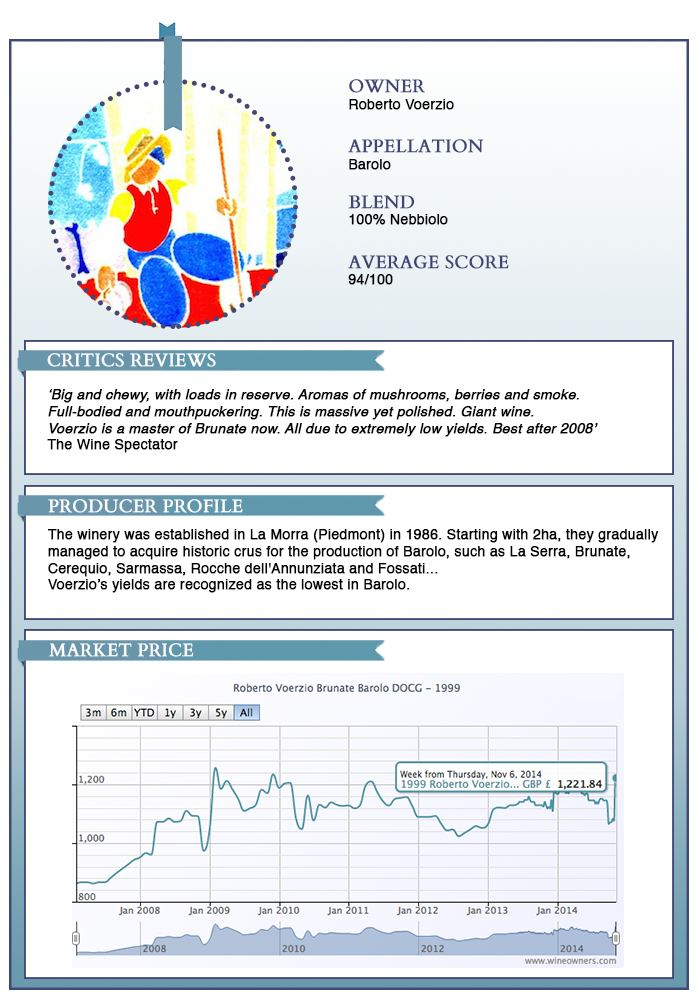
by Wine Owners
Posted on 2014-05-16
What was truly historic about this tasting was that every wine served was from magnum. Since Monfortino was not bottled in magnums every vintage (Roberto's father shied away from larger formats because they had to be hand-bottled) this tasting was of EVERY Monfortino vintage EVER bottled in mags.
The magnums all came from a collector in Italy, known to Roberto, and acquired by Antonio some time ago. Theoretically, because the wines have been stored in exactly the same conditions since release, what you were therefore tasting is the vintage differences, with the exception of the 1970 which was made from bought-in grapes as was the custom of the time. Cascina Francia was bought by Roberto's father in 1974.
The flights were arranged thematically. This was an inspired choice, with warmer vintages grouped together, cooler shades, modern day classics etc.
The magnums were decanted 4 hours in advance of the start of the dinner.
The wines were poured in advance of each course arriving, so that the wines could be tasted alone and with matched dishes.
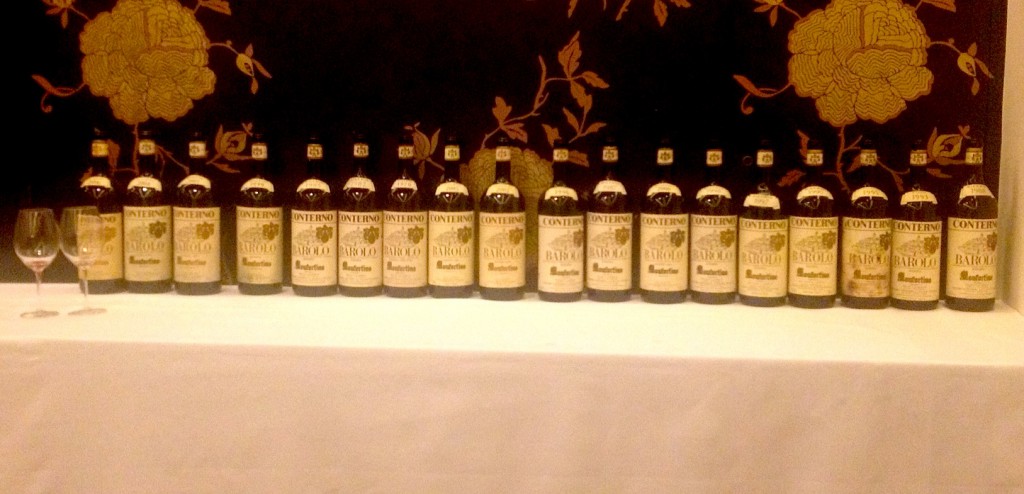
Flight 1: To Start
Served with crispy chicken thighs and charred lettuce.
1988
Ripe, expressive nose, sweet and pronounced pepperiness. Pale brick rim, limpid ruby core. Really thick glycerol. Grippy and bright, with a persistent citric thread. Mouthwatering finish with tertiary leafy notes.
An hour later a bit loose-knit.
1993
Cool nose. Pure creamy fruit, subdued pepper, orange brick rim with a deeply coloured core. Fresh, intense fruit, orange zesty, progressive cedar notes. A little closed on the mid-palate then blooms into a very long finish.
An hour later rich, confit, firm and excellent.
Wine of the flight.
1995
Sweet nose, elegant, fruity and floral. Pale pink rim with orange tinge. Fluid, integrated palate, crystalline and precise.
An hour later, very complete. Grippy, heady fruit, masculine.
Flight 2: The warm vintages
Served with a layered Foie gras terine, pomegranate, sauternes gel.
1990
Warm pepper nose, powerful and spirity. Translucent rim. So young on the palate, with an amazing entry that is grippy with thrilling acidity. So young.
An hour later less grippy but still super-fresh and exciting. Another decade?
1997
Very overt nose; subtle blueberry notes followed by macerated cherries and summer pudding. Blueberries on the entry, texturally dense with a lifted mid-palate, mouthwatering. Vivid fluid palate and finish. Very expressive yet fine.
An hour later, nose has calmed down beautifully, stunningly layered palate with floral notes. Wine of the flight.
1998
Creamy nose, white pepper, liqueur. Pale orange rim, shining ruby core. Warm entry, a little less precision than the preceding wine, softly spiced fruit, confit aftertaste and a vibrant, fabulously driven finish.
2000
Rye bread nose, spirity, herbal and fresh, with pinot-like undertones. Pink-tinged, strawberry-coloured core. Supremely elegant palate, soft yet dry. Aside from the nose, you would never guess this was the product of warm vintage.
Flight 3: cooler shades
Served with beef Fillet Tataki, pickled onion and something called Wakame.
1987
Rich, heady nose, deep colour, pink tinged rim. Energetic and intense, dramatic yet elegant. Floral mid palate, powerfully and progressively builds to an endless finish. Perfect balance.
Wine of the flight (head)
1996
Not a good bottle sadly. Oxidative Bovril nose, fresh and mouthwatering , sherbet finish, short and un-knit. This was the better of the 2 bottles opened apparently, the first being corked (not served).
2002
Sweet, perfectly poised nose of red and soft fruits. Reminiscent of pinot within the strawberry flavor spectrum. Sweet, gentle pastille fruit. Very long. Beautiful and one for burgundy lovers. Adorable.
Wine of the flight (heart)
2005
Macerated fruit nose. Savoury notes with grippy cool tannins then dark brooding fruit with a sour twist to the mid-palate, before pushing on to an enduringly deep but firm finish.
An hour later, perfectly resolved.
Flight 4: the epic vintages
Served with cannon of lamb and lamb belly, cauliflower pureé and lentils - a masterpiece.
1970
Very alluring savoury nose. Surprisingly deep colour. Slightly gamey, intense and powerful, complex and perfectly poised. Flavours contained by the evident structure of the wine. The wine sings properly with the lamb.
Wine of the flight.
1982
Saline nose, faintly oxidative before it blows off then pure sweet fruit. Slightly volatile, very bright sexy fruit, very intense confit character lifted by a powerful freshness.
1995
Darkly fruited nose, very pure. Translucent scarlet colour. Such a lovely balance. Grainy palate. Elegant, deeply veined fruit.
1999
Primary nose of pure fruit, edgeless. Primary colour with the merest hint of a maturing rim. Stuningly defined, intense but balanced fruit. So refreshing. The ultimate food wine and a future monument for 10-20 years hence.
Future icon of the night.
Flight 5: modern day classics
Served with cheese.
2001
White pepper nose, pure and pale rimmed, limpid ruby, pretty medium weight.
2004
Ripe, fleshy and overtly fruity nose. Deep colour, purple-rimmed. Structured, powerful, grainy palate.
2006
Peppery, fruity, fresh cool nose. Classic form. Very pretty ruby colour. Glycerol drenches the side of the glass. Stunningly pure, linear fruit
Wine of the flight.

by Wine Owners
Posted on 2014-02-06
Average cellar size £60,000
Total cellars under management £40m
|
January |
Overall |
| Bordeaux |
26% of total trades |
39% |
| Tuscany |
23% |
12% |
| Rhone |
21% |
13% |
| Burgundy |
21% |
17% |
Enthusiastic reviews from Antonio Galloni seem to have piqued interest in the 2010 vintage in Tuscany and Piedmont, with back vintages in Tuscany hanging on the coat-tails of the 2010. The tried and tested Supertuscans seem to be the big winners, with trading users offering and bidding around Sassicaia, Ornellaia and Masseto in mid January, with a high correlation of offers to trades across the region.
The inclusion of some excellent new private collections of Rhone and Burgundy in December and January have pushed up the market share of those regions to rival Bordeaux in those months, with a spread of private and trade buyers picking up top wines from producers like Guigal, including a rare parcel of 1989 la Turque trading at £2,900.
Bordeaux, even in a relatively flat market for the region, continued to account for the largest percentage of Exchange trades in January. Interest focusses around classic wines such as 1982 Latour (recent trades at £13,300), top scorers, and ‘off’ vintages, particularly among the first growths. On the right bank in particular, 2005 appears to be attracting new interest where the price is right, so perhaps the prospect of an uninspiring En Primeur season is already encouraging sparks of interest in great vintages with a track record of quality and performance.
Index comparisons show a relatively flat year’s market, with Medoc Classed Growths slightly underperforming, and top level Burgundy slightly bucking the trend by showing 5.6% growth compared to a base value at Feb 2013.
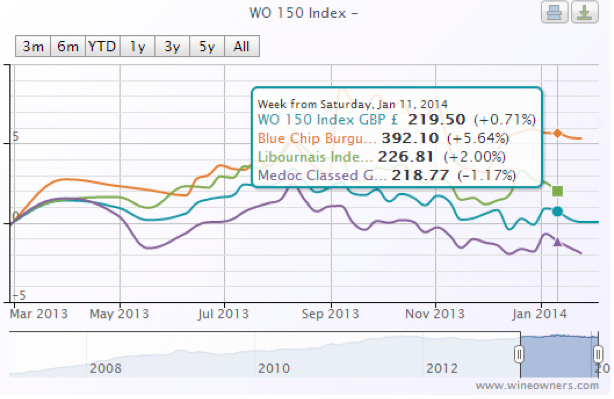
by Wine Owners
Posted on 2014-01-06
Worthy of attention on the Exchange this week as a value proposition is the 2010 Coparossa Barbaresco from Bruno Rocca, which outperforms the theoretically superior 2007 vintage but still comes in marginally lower priced (the 2007 appears in the UK market at a low of £211). The Coparossa is effectively a ‘vieilles vignes’ cuvee, sourced from older plantings in First floors of Neive and Treiso, so marks a qualititative step up from the straight Barbaresco bottling, from younger vines, but is not a single vineyard cuvee like the Rabaja. Antonio Galloni and Wine Advocate seem to be in accord that the 2010 Coparossa is the best yet made from a producer who seems to be very much on an upward trajectory in terms of quality and reputation.
According to Galloni, it’s clear from what he has tasted that ‘the best wines from this small, family-run domaine have yet to be made, and that is more than enough to be energised about what is happening here.’ With a constant build in quality, and the fact that in many vintages the Coparossa outscores the single vineyard bottling, the 2010 vintage looks like decidedly good value.
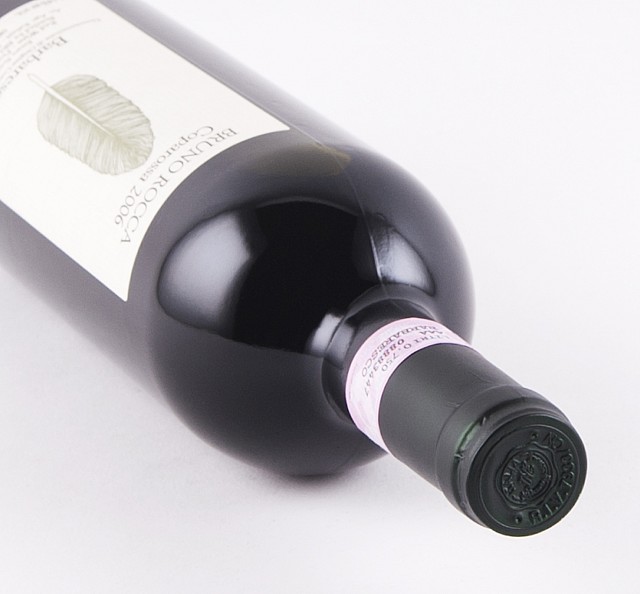
“The 2010 Barbaresco Coparossa brings together the structure of the year with a huge core of fruit, a combination that is hugely appealing. Dark red cherry, plum, cinnamon, licorice and leather all blossom in an expressive, layered wine loaded with personality. With time in the glass, the wine turns explosive. Orange zest, rose petals and cloves linger on the exotic finish. The style is energetic, tense and vibrant.”
95 (1997- 93 pts) Antonio Galloni, Vinous Media
“The 2010 Barbaresco Coparossa is extremely elegant and refined with dried flowers, herbal notes, bright cola and Pinot-like softness. This is a stunning effort. The wine is irresistibly silky and sensuous on the palate, imparting clean fruit flavors that last long on the finish. It delivers fabulous length with seemingly never-ending intensity and persistency.”
Anticipated maturity: 2015-2028.
96 points, Monica Larner, Wine Advocate

